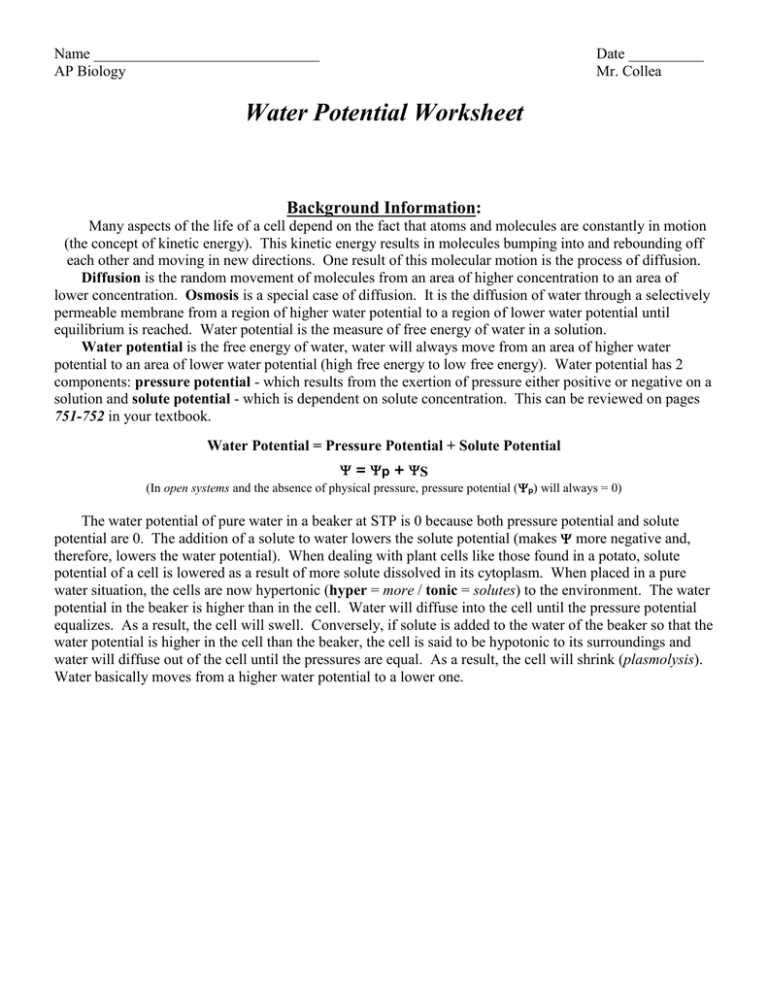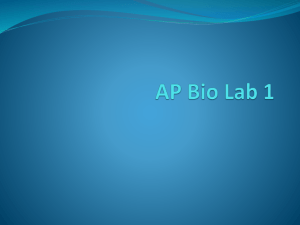Water Potential Questions
advertisement

Name ______________________________ AP Biology Date __________ Mr. Collea Water Potential Worksheet Background Information: Many aspects of the life of a cell depend on the fact that atoms and molecules are constantly in motion (the concept of kinetic energy). This kinetic energy results in molecules bumping into and rebounding off each other and moving in new directions. One result of this molecular motion is the process of diffusion. Diffusion is the random movement of molecules from an area of higher concentration to an area of lower concentration. Osmosis is a special case of diffusion. It is the diffusion of water through a selectively permeable membrane from a region of higher water potential to a region of lower water potential until equilibrium is reached. Water potential is the measure of free energy of water in a solution. Water potential is the free energy of water, water will always move from an area of higher water potential to an area of lower water potential (high free energy to low free energy). Water potential has 2 components: pressure potential - which results from the exertion of pressure either positive or negative on a solution and solute potential - which is dependent on solute concentration. This can be reviewed on pages 751-752 in your textbook. Water Potential = Pressure Potential + Solute Potential = p + S (In open systems and the absence of physical pressure, pressure potential (p) will always = 0) The water potential of pure water in a beaker at STP is 0 because both pressure potential and solute potential are 0. The addition of a solute to water lowers the solute potential (makes more negative and, therefore, lowers the water potential). When dealing with plant cells like those found in a potato, solute potential of a cell is lowered as a result of more solute dissolved in its cytoplasm. When placed in a pure water situation, the cells are now hypertonic (hyper = more / tonic = solutes) to the environment. The water potential in the beaker is higher than in the cell. Water will diffuse into the cell until the pressure potential equalizes. As a result, the cell will swell. Conversely, if solute is added to the water of the beaker so that the water potential is higher in the cell than the beaker, the cell is said to be hypotonic to its surroundings and water will diffuse out of the cell until the pressures are equal. As a result, the cell will shrink (plasmolysis). Water basically moves from a higher water potential to a lower one. Water Potential Questions: Using the formula below, calculate the solute potential and water potential for each of the lab set ups. Remember ESA! Water Potential: = P + S Solute Potential : ψs = -iCRT i = Ionization constant (for sucrose i = 1) C = Molar concentration R = Pressure Constant (R = 0.0831 liter bars/mole oK) T = Temperature (oK) (273 + oC of solution) Remember: In open systems and the absence of physical pressure, pressure potential (p) will always = 0) 1. Calculate the solute potential and water potential of a 0.0 M sugar solution at 22 oC. solute potential water potential ψs = -iCRT = P + S 2. Calculate the solute potential and water potential of a 0.2 M sugar solution at 22 oC. 3. Calculate the solute potential and water potential of a 0.4 M sugar solution at 22 oC 4. Calculate the solute potential and water potential of a 0.8 M sugar solution at 22 oC.




